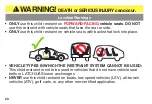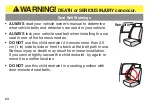
15
Child Requirements
Booster Mode
When to put your child in a Booster
Booster seats raise the child up and help to position the vehicle lap and shoulder
belt correctly. When the child is properly restrained in a booster seat, their risk
of injury in all types of crashes is reduced, as the lap and shoulder belt provide
excellent restraint of the upper and lower torsos.
It is important for the child to sit properly within the vehicle seat belts. When the
vehicle belt is buckled, the lap belt should be low on the hips, just touching the
thighs, and the shoulder belt should lie across the middle of the shoulder. If the
child leans out or moves the belt behind the back or places it under the arm, it will
not provide the intended restraint.
You should consider using a booster seat if the following conditions apply:
•
The child is approaching/has exceeded the weight or height limit of their child
restraint's current mode of use. Even children who have not outgrown their child
restraint can benefit from the use of a booster seat if it is used properly.
•
The child is mature enough to sit in the booster seat and not put the belts under
their arm or behind their back.
•
If you have a vehicle that does not have a tether anchorage but has lap/shoulder
belts available in the back seat, a booster seat may provide better protection
than an internal harness seat without the tether.
















































